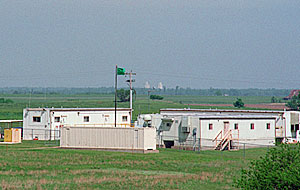SGP Operations
Routine Operations

SGP central facility offices.
The overwhelming majority of the measurements with the highest priority, on which the existing experimental designs are based, are regular routine observations, as specified in the ARM Program Plan, 1990 (U.S. Department of Energy 1990). Scientifically and logistically, routine operations also serve as the basis and background for all nonroutine operations, including instrument development activities, intensive operational periods (IOPs), and collaborative campaigns directed toward obtaining difficult-to-gather or expensive in situ data. Consequently, development and validation of the basic observations remain high priorities. The SGP site is sufficiently mature to support IOPs addressing key scientific areas of study.
Routine operations are the activities related to the operation and maintenance of instruments; the gathering and delivery of the resulting data; and the planning for scientific investigations, including IOPs, campaigns, value-added products (VAPs), and quality measurement experiments (QMEs). Although the site is essentially complete, instrumentation is evaluated continuously to assess its effectiveness in helping to meet the ARM Program's goals for the SGP site.
The design expectation for the routine operation of instruments is that they will continue to require servicing by site operators only once every two weeks. The exception to this is the central facility, which is staffed. If an instrument failed during a two-week period at an extended facility, communication, data streams, or both could be lost, although every effort is made to ensure that data-logging capacity is adequate at each location.
Site operations staff conduct additional instrument "triage" during IOPs and campaigns. The triage plan calls for IOP scientists to identify instruments, individual sensors, and communication links that are critical to the operation and goals of the IOP, so that these instruments can receive more frequent servicing than is prescribed by the routine operational requirements mentioned above. The priority of triage efforts is determined by IOP scientists, the Site Scientist Team (SST), and the site program manager, who take into consideration the scientific importance of a particular data stream and its expense.
With the activation of our calibration facility in 1996, and our electronics repair lab in 1998, the SGP has significantly reduced instrument calibration error, instrument repair time, and service costs. Handling of instruments that must be returned to the vendor for calibration and servicing is also part of routine operations. Replacement instruments and sensors are rotated regularly to meet these requirements. Calibration and maintenance information is compiled, both to operate and maintain site instruments properly and to provide pertinent information to data users. Changeouts of all sensors and instrumentation are recorded in the site operations log.
This past spring, a temperature-relative humidity calibration chamber was installed at the central facility. The system has already been used to verify calibrations of the aspirated psychrometers used during preventive maintenance checks for SMOS instruments at each of the extended facilities. In addition, the chamber has been used to intercompare SGP and TWP chilled hydrometers. Steps are being taken to modify the chamber so that SGP technicians can perform and certify calibrations for temperature and humidity sensors for all three ARM sites.
Initial checks of data quality after instrument installation are provided by the instrument mentors. After the mentor reviews the data stream to ensure that the acquired instrument is performing properly and that the data are identified accurately by the Experiment Center, the mentor approves a "beta" release of the data. The beta release provides data to selected Science Team members who have requested them and are willing to work with the instrument mentor on data quality issues. Beta releases are established after the instrument mentor and an appropriate member of the Data and Science Integration Team (DSIT) have created a general statement on data quality for the Experiment Center. When the data quality relative to proper instrument functionality is consistently acceptable and well documented, the mentor approves a full release of the data.
For more information about routine observations, instrument and facility logs and maps, operational status data, logistics support, instrument inventory, operations procedures and plans, and site safety, visit the Operations Management Information System (OMIS)—restricted access.
Radiosonde Launch Schedules
The schedule for routine launch operations during this period is in Table 2. The routine radiosonde launch times, approved by the Science Team Executive Committee, were chosen to complement the National Weather Service standard launch times of 0000 and 1200 Universal Time Coordinates (UTC) and to support the daytime satellite advanced very-high-resolution radiometer (AVHRR) overpass at approximately 2030 UTC.
In addition, the 2030 UTC launch during the maximum daytime boundary layer height supports instantaneous radiative flux (IRF) research. The midnight launch provides the only deep tropospheric nighttime information. Remote sensing of virtual temperature profiles at all boundary facilities is performed by the nearby National Oceanic and Atmospheric Administration (NOAA) profilers, which are being outfitted with ARM-provided radio acoustic sounding system (RASS) units. The RASS units have already been installed at the Purcell, Oklahoma, and Haviland, Kansas, NOAA profilers. The Lamont, Oklahoma, NOAA profiler will not receive a RASS unit because the location is too close to a residence, but the nearby SGP site central facility collects a relative abundance of thermodynamic data. In addition, global positioning system (GPS) instruments were recently installed at the Purcell, Vici, Haskell, Haviland, Lamont, Neodesha, and Hillsboro NOAA profiler locations to provide estimates of precipitable water. This information, along with the NOAA profiler data, has become available to the ARM Program as external data.
Staffing of Facilities
The central facility is staffed from 0530 to 2030 CDT (central daylight time) (0430-1930 CST [central standard time]) and from 2330 to 0330 CDT (2230-0230 CST), Monday through Friday (including holidays, although staffing is limited).
During normal single-column model (SCM) IOPs, the central facility and the four boundary facilities will be staffed 24 hours per day, 7 days per week (including holidays) to facilitate round-the-clock radiosonde releases every 3 hours, centered on 0000 UTC.



